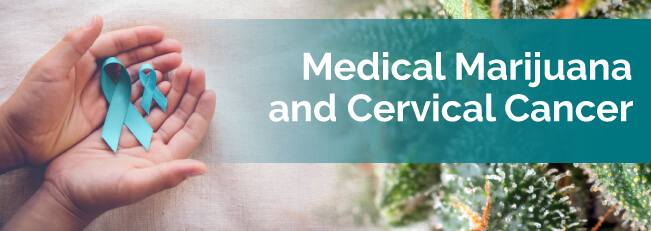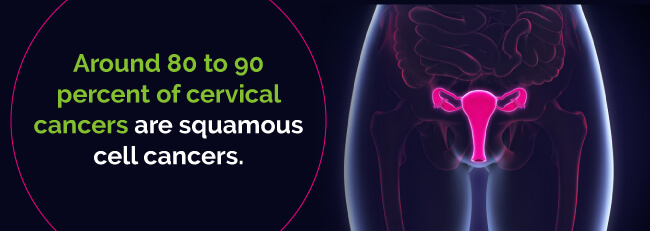
It doesn’t surprise people to learn weed has anti-carcinogenic characteristics, antiemetic benefits, pain-relief properties and more. All over the globe, researchers have proven various forms of the herb have powerful symptom-relieving effects of even the most malignant types of cancer and its treatment.
While research is in its infancy, early findings are encouraging. Some studies suggest marijuana compounds may be able to stop certain cancerous cells from spreading, potentially slow the progression of cancer growth and relieve the side effects of chemotherapy and other cancer treatments. In this guide, we look specifically at medical marijuana for cervical cancer, and how it might be an alternative option for you or your loved one to consider when facing this disease.
A South African North West University lab conducted a handful of experiments using cannabis sativa extracts and a cancer model. The researchers found the cannabis sativa extract didn’t just stop cancer cell growth but also killed cancer cells.

Cannabidiol (CBD) was the active compound in the extract. Researchers believe the CBD compound’s action activates a Bcl-2 degradation pathway. Bcl-2 keeps the cells alive, so when degraded, the cells kill themselves. Preliminary findings are encouraging, but researchers need to conduct more studies.
Another study found medical marijuana serves as a preventative agent and reduces inflammation, which according to the researchers, is helpful in reducing the chances of cancer.
Find A Doctor Find A Dispensary
Medical cannabis for cervical cancer can help with:
Dr. Donald Abrams, professor of clinical medicine at San Francisco’s University of California and San Francisco General Hospital’s chief of hematology and oncology told Newsweek there wasn’t a day he didn’t see a cancer patient with pain, nausea and vomiting, insomnia, depression and loss of appetite. And, according to Dr. Abrams, the only anti-nausea medication to increase your appetite is marijuana. Ingesting medical pot enables patients not only to eat but also keep their food down, helping to combat muscle wasting and weight loss.
Most patients only need a few hits of marijuana to eliminate their nausea. Patients who are trying cannabis for the first time for medicinal reasons are often shocked at how effective it is and how rapidly it works.

A study published in the British Journal of Pharmacology has demonstrated that a type of CBD found in marijuana has antiemetic properties. Another study published in The New England Journal of Medicine found oral tetrahydrocannabinol (THC), a chemical in marijuana reduced vomiting caused by chemotherapy significantly better than a placebo.
Along with alleviating nausea and stimulating the appetite, cannabis for cervical cancer also helps cancer patients who are dealing with pain due to their chemotherapy treatment. A Harvard-led review of nearly 30 studies of cannabinoids used to treat pain revealed that using cannabis resulted in substantial improvement in six of the generalized chronic pain studies.
Further, cannabis can combat anxiety and depression — two serious conditions that can knock down a patient emotionally when they’re already struggling from the physical and psychological ravages of cancer and chemotherapy.
Some marijuana strains you may want to try out to help combat your symptoms include the following.
The information presented here shouldn’t replace the recommendations of a qualified marijuana doctor or explanations given to you by a knowledgeable budtender.
When it comes to smoking medical marijuana for cervical cancer, there have been some concerns that inhaling the smoke of the herb could lead to lung cancer development.
Researchers, however, conducted a detailed analysis where they only found a very weak relationship between cannabis smoking and lung cancer development. And, the researchers also concluded there wasn’t sufficient evidence that habitually smoking marijuana may increase a person’s risk of lung cancer.
A similar study back in 2005 the Harm Reduction Journal published claimed smoking cannabis isn’t the same thing as smoking tobacco, nor is it as carcinogenic. They concluded the real culprit of causing cancer of the lungs was tobacco smoke. Smoking marijuana and cervical cancer and smoking tobacco aren’t inherently the same.
And even so, it’s worth taking note these potential effects don’t change marijuana’s anti-cancer properties to treat cervical cancer and are only limited to smoking the herb.

Because of this, the best methods of medical cannabis consumption could be in the form of tinctures, edibles, capsules and vaporizable oils. These allow you to inhale cannabis in vapor form or ingest it so you can avoid even the potential minor risk associated with smoking marijuana.
With all the evidence pointing to the effectiveness of marijuana for cervical cancer, it’s no wonder patients are becoming more curious and eager to try this treatment to help relieve their symptoms, particularly for their pain, fatigue and nausea. If you’re considering this powerful herb, use our directory to search for a cannabis dispensary or connect with a medical marijuana doctor.
Find A Doctor Find A Dispensary
Cervical cancer is a form of cancer that starts in a woman’s cervix, the uterus’s narrow opening from the vagina. The ectocervix, the section of the uterus that extends into the vagina, is pink and covered with thin, flat squamous cells. Columnar cells make up this cervical canal. The transformation zone, known as the T-zone, is where these cells meet and is the area more likely to develop precancerous or abnormal cells.
The human papillomavirus (HPV) virus is the leading cause of most cervical cancers. You get HPV when you have sexual contact with another person who has the virus. There are various forms of the HPV virus, but not all of these types lead to cervical cancer. Some types cause genital warts, while others don’t cause any symptoms.
Most adults at some point in their lives have had HPV. And while the infection could just go away on its own, many cases lead to genital warts and worse, cervical cancer. Because of this, women are urged to have regular PAP tests yearly or every two years. Pap smears can detect any cervical cell changes you have before the cells turn into cancer. Treating these cell changes helps prevent cervical cancer.
Around 80 to 90 percent of cervical cancers are squamous cell cancers. The second most common form of cervical cancer is adenocarcinoma and accounts for the other 10 to 20 percent of cervical cancer cases. Adenocarcinoma develops from your mucus-producing glands in your endocervix. Although not as common as squamous cell carcinoma, adenocarcinoma cases are increasing, especially in younger women.

F. Hoffmann-La Roche Ltd provides an interesting timeline of the history of cervical cancer screening. In the 1920s, there was no screening for cervical cancer. Doctors used symptoms to detect cancer, which often meant the disease was already in its late stages and death was likely. During this time, doctors missed 100 percent of pre-cancer or cervical cancer in its early stages.
The 1940s saw the introduction of cervical screenings. Screenings involved PAP tests, which decreased the number of deaths due to cervical cancer exponentially. Unfortunately, many women didn’t receive a proper diagnosis. During this time, annual PAP tests missed around 50 percent of pre-cancers in women.
In the early to mid-2000s, new approaches to screening based on molecular tests were introduced. HPV testing detected high-risk HPV to identify women who were at a higher risk of cervical disease. Also, new biomarker testing identified HPV infection-related transforming cells to determine when immediate intervention would help and to provide cervical disease diagnoses. With new screening testing, healthcare professionals missed detecting around 10 percent or fewer cases of pre-cancer.
Cervical cancer used to be the most common cancer American women died from, but the cervical cancer death rate over the past 40 years has declined by over 50 percent. The American Cancer Society estimates that, in 2017, around 12,820 new diagnoses of invasive cervical cancer will occur and that 4,210 women will die from the disease.

Precancerous cervical cell changes or early cervix cancers typically don’t cause symptoms. Because of this, HPV and PAP tests are regularly screened to help detect precancerous cell changes early enough to prevent cervical cancer development.
Potential symptoms of more advanced cervical cancer could include irregular or abnormal bleeding from your vagina, vaginal discharge or painful sex. Consult with your doctor if you experience:
Any of these symptoms could indicate another health condition and not specifically cervical cancer, so be sure to talk with your doctor if you’re experiencing any of them.
Cervical cancer can wipe you out physically, but it may drain you emotionally as well. Receiving a cervical cancer diagnosis, going through treatment and having to deal with the stress of all of that can leave you feeling overwhelmed and tired. If part of your treatment is to undergo a hysterectomy, this can be especially distressing.
A diagnosis of cervical cancer can put a great deal of worry, stress and anxiety on both you and the people you love. Paying attention to your emotional health during this trying time and encouraging those around you also to seek support is vital.
Having to cope with recovery after your treatment can carry its own set of stresses. Once you complete treatment, you may feel some relief and excitement, but you’ll also likely worry about your cancer’s return, particularly during the first couple months after your treatment.
Several factors determine the type of treatment you receive for your cervical cancer. These factors may include:
Common treatments for cervical cancer include radiation, chemotherapy, surgery or a combination of any of the three. And medical marijuana for cervical cancer is now an alternative treatment as well.
During radiation therapy, your doctor uses high-powered energy beams, like protons or X-rays, to kill cancer cells. They may use radiation therapy by itself or combine it with chemotherapy to shrink a tumor before you go into surgery or to kill any remaining cancer cells left after surgery.
Your doctor may give you radiation therapy:
Women going through premenopause may stop menstruating and start menopause after receiving radiation therapy. Before you start treatment, ask your doctor about how you can preserve your eggs if you plan on getting pregnant after you receive radiation therapy.
Other potential radiation side effects may include:
Chemo uses medications the doctor typically injects into your veins to kill the cancerous cells. They may combine radiation therapy with low doses of chemo since chemotherapy enhances the radiation effects. If your cervical cancer isn’t curable, your doctor may give you higher doses of chemo to control the disease.
Chemotherapy side effects may include:
If your cervical cancer is in an early stage, your doctor may suggest surgery to remove your uterus, which is a procedure known as a hysterectomy. It can cure cervical cancer in its early stage and prevent recurrence. But, once you’ve had a hysterectomy, you won’t be able to get pregnant.
Your doctor may suggest:
As mentioned above, no matter what type of hysterectomy you get, it results in infertility. While rare, side effects of this surgery may include:
If you’re in your earlier stage of cervical cancer and there’s no lymph node involvement, you may be a candidate for a fertility-preserving surgery where you still can become pregnant after surgery.
Your doctor will encourage you to make follow up visits after your treatment is complete.
Palliative care is a particular type of medical care focusing on providing you relief from your symptoms. Specialists will work closely with you, your doctors and your family to offer you extra support on top of your ongoing care. Receiving palliative care along with your treatment may help give you a better quality of life and may even extend life.